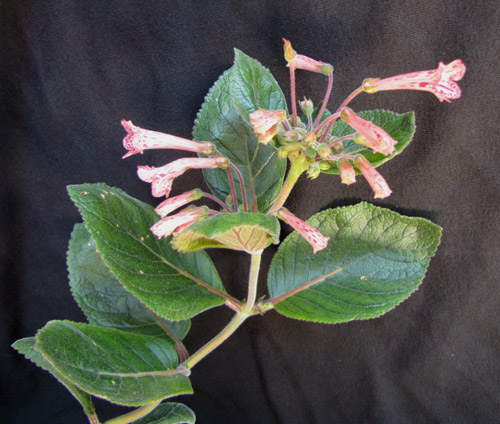
| Species list |
Hybrids list |
Tubers list |
Topics list |
Site index |
What's new |
Home page |

|
Sinningia striata |
|
Sinningia striata first bloomed for me in June 2012. For a couple of years, I had it under artificial light, but it never flowered. It also sprawled. In 2011, I put it outdoors, in a place where it got a couple hours of direct sunlight, and was rewarded. It survived the winter just fine, and bloomed. I was motivated to give it some direct sun by its resemblance to S. rupicola, which also seems to appreciate bright light. The main visual difference between the two species is that Sinningia striata bears flowers in axillary cymes while Sinningia rupicola has a terminal inflorescence. |

|

|
Small plant, while it was still under artificial light. |

|
S. striata is one of the grandparents of Dale Martens's hybrid S. "Texas Zebra", which shows some of the striping of this species. |
| Plant Description |
|
| Growth | Indeterminate |
| Habit | Upright or sprawling stem with leaves paired or in whorls of three |
| Leaves | Green with maroon backs. As is often the case, the maroon color is more intense if the plant is grown under artificial light. |
| Dormancy | Plant has a tuber. Stems on my plant were not deciduous during the winter of 2010-2011, but the plant went dormant during the winter of 2011-2012, when it was outdoors. Since then it has gone dormant every year. |
Flowering |
|
| Inflorescence | Extended axis |
| Season | Spring-summer |
| Flower | Red, tubular, striped |
Horticultural aspects |
|
| Hardiness | Tuber survived 28 F. |
| Recommended? | Only if you can grow it outdoors. So far the plant has stayed relatively compact. |
Botany |
|
| Taxonomic group | The douglasii group of the Dircaea clade. |
PublicationFritsch, 1900, as Corytholoma striata. Chautems, 1995, in Gesneriana 1(1), transferred it to Sinningia. Quoting from Gesneriana: "In 1989 Mauro Peixoto and I found this species growing on top of the Pedra Blanca, Minas Gerais; this mountain is the locality where the type material had been collected by MosÚn in 1873. It differs from S. rupicola (Mart.) Wiehler by its much larger size, leaf shape and ecology." Etymology: Latin striatus [from stria ("groove or ridge")]. Usually used in the sense of "striped". External LinkMauro Peixoto's Brazilian Plants site has a page about S. striata. |